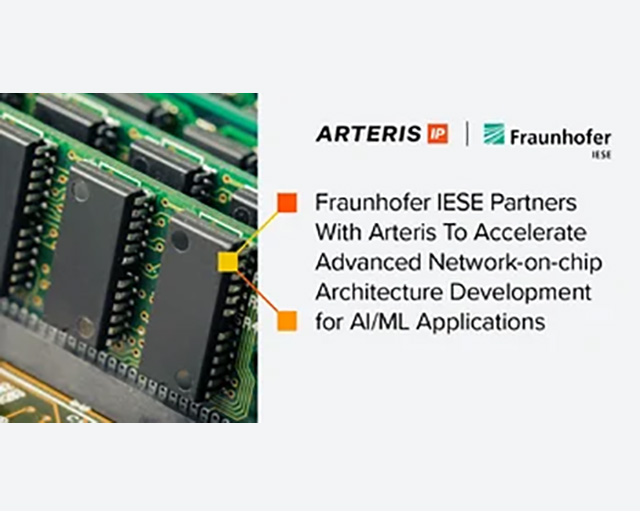Fraunhofer IESE Partners With Arteris To Accelerate Advanced Network-on-chip Architecture Development for AI/ML Applications
Combining FlexNoC and Ncore from Arteris with Fraunhofer-Institut für Experimentelles Software Engineering IESE DRAMSys4.0 enables customers to improve performance, reduce cost and accelerate the advanced DRAM-centric SoC development schedules.

Arteris, Inc. (Nasdaq: AIP), a leading provider of system IP which accelerates system-on-chip (SoC) creation and Fraunhofer IESE, one of the leading research institutes in the area of software and systems engineering methods, today announced they have partnered to enable interoperability between Arteris' FlexNoC and Ncore network-on-chip (NoC) development environment and Fraunhofer IESE's DRAM subsystem design space exploration framework. The interoperability will improve performance, reduce cost and accelerate the schedule of advanced DRAM-centric NoC development for mutual customers.
Professor Dr. Matthias Jung, an expert in virtual engineering at Fraunhofer IESE:
"Early, accurate modeling of the characteristics of the latest DRAM architectures is a critical component to arrive at optimal power-optimized SoC architectures. By enabling interoperability and integration between Arteris' FlexNoC and Ncore with DRAMSys4.0, our customers can understand the impact of advanced DRAM technology on NoC performance and power consumption at the earliest project stages, avoiding surprises leading to architecture redesigns later in the project cycle."
DRAM performance is critical for today's advanced AI/ML architectures due to requirements on efficiency of data movement, computation, AI model complexity, real-time inference and energy consumption. While models of memory controllers impact memory access mapping, command generation and timing control, memory organization, configuration and error correction, memory models also manage data storage, access, retrieval, refresh and retention. DRAMSys consists of models that reflect the DRAM functionality, power, and temperature. It allows system designers to analyze the limiting parameters and issues concerning current DRAM standards in the context of system and NoC architectures. The interoperability between Arteris and Fraunhofer IESE technology enables designers to complete a thorough performance analysis in the context of DRAM architectures before committing to a NoC architecture.
"Generative AI SoCs have memory-centric architectures. The performance and flexibility of Arteris interconnect IP products support ultra-high bandwidth traffic to feed data to advanced memory architectures supported by the Fraunhofer IESE memory exploration framework," said Frank Schirrmeister, vice president solutions and business development at Arteris. "Together, we can enable our customers to reduce cost and schedules for their highly differentiated and performance-optimized NoC architectures."
"We are more than happy that this project, which started as a research endeavor at RPTU Kaiserslautern-Landau, was further developed with Fraunhofer IESE into a tool that is now used in the industry," said Professor Dr. Norbert Wehn from the RPTU University of Kaiserslautern-Landau. “This collaboration is a positive step forward for designers everywhere.”
The integration of Arteris and Fraunhofer IESE offerings is available today. For more information contact info@arteris.com and anfrage@iese.fraunhofer.de.
Last modified: